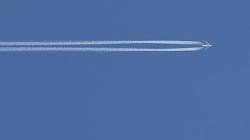Climate model shows that cleaner aircraft emissions reduce the climate impact of contrail cirrus
Halving the ice particles that form in the contrail decreases the climate-warming effect of the contrail cirrus by 20 percent. The effect is halved if there are 80 percent fewer ice crystals. This is shown in a study conducted by the German Aerospace Center (Deutsches Zentrum für Luft-und Raumfahrt; DLR), the results of which have been published in the Nature Partner Journal (npj) Climate and Atmospheric Science.
"Based on our theoretical model calculations, we were able to establish how fewer ice crystals reduce the optical thickness of the contrail cirrus, due to the reduced numbers of soot particles, and also shorten the lifetime of the clouds," says DLR's Ulrike Burkhardt. "Overall, this results in less cloud cover due to contrail cirrus-induced clouds and a lower climate impact. A reduction in soot particle emission is particularly effective during significant contrail cirrus outbreaks."
The interplay between the choice of fuel and combustion in the engine is decisive in reducing soot emissions in aviation. For example, new engine technologies enable soot emissions to be reduced as a result of combustion at higher temperatures, even using conventional fuels.
Intensive research is being carried out into the reduction of soot emissions through the use of alternative fuels with a lower proportion of cyclic hydrocarbons, which have a significant influence on the formation of soot in the combustion process. DLR and NASA conducted joint research flights in January 2018 to investigate the effect of different fuel blends on soot emissions and the associated formation of ice crystals. Based on data from the research flights, the researchers hope to demonstrate in practice and in detail the theoretically estimated reduction in the formation of ice crystals through less soot. The results are expected in summer 2019.
Ready to make a purchase? Search the Intelligent Aerospace Buyer's Guide for companies, new products, press releases, and videos
